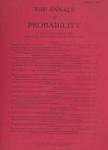-
作者:Barany, Imre; Vu, Van
作者单位:Hungarian Academy of Sciences; HUN-REN; HUN-REN Alfred Renyi Institute of Mathematics; University of London; University College London; Rutgers University System; Rutgers University New Brunswick
-
作者:Beffara, Vincent
作者单位:Ecole Normale Superieure de Lyon (ENS de LYON); Centre National de la Recherche Scientifique (CNRS); CNRS - National Institute for Mathematical Sciences (INSMI)
摘要:Let gamma be the curve generating a Schramm-Loewner Evolution (SLE) process, with parameter kappa >= 0. We prove that, with probability one, the Hausdorff dimension of gamma is equal to Min(2, 1 + kappa/8).
-
作者:van den Berg, J.
摘要:One of the most well-known classical results for site percolation on the square lattice is the equation p(c) + p(c)* = 1. In words, this equation means that for all vaues not equal p(c) of the Parameter p. the following holds: either a.s. there is all infinite open cluster or a.s. there is an infinite closed star cluster. This result is closely related to the percolation transition being sharp: below p(c), the size of the open cluster of a given vertex is not only (a.s.) finite. but has a dist...
-
作者:Adamczak, Radoslaw; Latala, Rafal
作者单位:Polish Academy of Sciences; Institute of Mathematics of the Polish Academy of Sciences; University of Warsaw
摘要:We give necessary and sufficient conditions for the (bounded) law of the iterated logarithm for canonical U-statistics of arbitrary order d, extending the previously known results for d = 2. The nasc's are expressed as growth conditions on a parameterized family of norms associated with the U-statistics kernel.
-
作者:Hara, Takashi
作者单位:Kyushu University
摘要:We consider nearest-neighbor self-avoiding walk, bond percolation, lattice trees, and bond lattice animals on Z(d). The two-point functions of these models are respectively the generating function for self-avoiding walks from the origin to x epsilon Z(d), the probability of a connection from the origin to x, and the generating functions for lattice trees or lattice animals containing the origin and x. Using the lace expansion, we prove that the two-point function at the critical point is asymp...
